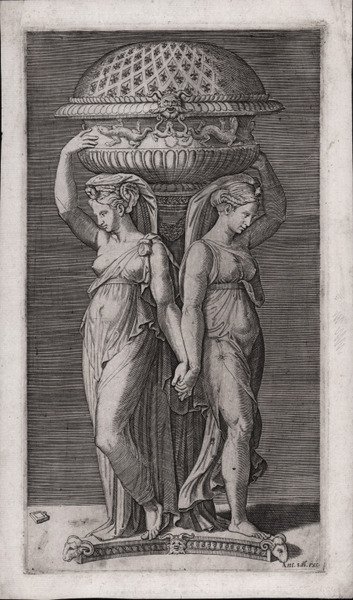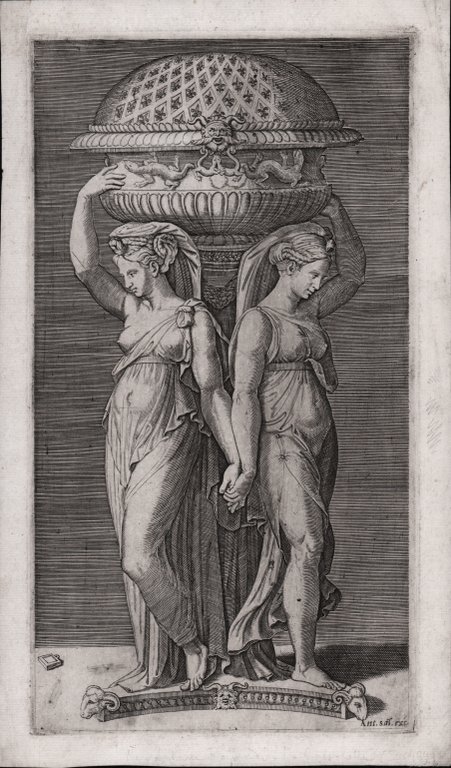Bulino, 1518-1520 circa, firmato, in basso a sinistra, con la tavoletta. Esemplare nel secondo stato edito dal Salamanca: in basso a destra Ant. Sal. exc. Sin dal Vasari, che nomina l’incensiere tra le opere di Agostino Veneziano (V, p. 415), si ritiene che l’incisione riprenda un disegno di Raffaello per opera di oreficeria; solo Bianchi (in Raffaello, p. 689, nota 265) pensa a Giulio Romano da un disegno di Raffello. Per la parte superiore è stato individuato un prototipo antico nella fontana sostenuta da Sileni nel Museo Pio Clementino di Roma (cfr. Mason in Raphael et la seconde main, 1984, p. 78 n. 96) e nel cosiddetto Vaso Torlonia, che fino agli anni trenta del Cinquecento si trovava in San Francesco in Trastevere, come attestato dall'Aspertini (Bober-Rubinstein 1986, n. 92). Le figure della parte inferiore sono state invece collegate alla Venus genitrix visibile nel disegno di Raffaello all'Albertina (inv. 179). Le due cariatidi si inseriscono senza dubbio nell’opera tarda dell’Urbinate, intorno al 1518-1520. I corpi sono slanciati e hanno un movimento estremamente flessuoso; non v’è traccia di sforzo, e le membra non sono più plasticamente tese come nelle Due donne con i segni zodiacali della Bilancia e dello Scorpione (1516-1518 circa). La presenza dei gigli e delle salamandre ha indotto a concludere che l’incensiere fosse destinato a Francesco I; potrebbe essere stato inviato in Francia come dono di Leone X e Lorenzo de’ Medici, insieme al San Michele e alla Sacra Famiglia di Raffaello, nel 1518, anche se non è sicuro che l’oggetto sia mai stato realizzato. Presumibile è almeno una datazione del progetto al 1518-1519; l’incisione dovrebbe risalire allo stesso periodo. L’incisione di Raimondi, secondo Gnann, sarebbe basata non sul disegno di Raffaello ma sull’incisione realizzata da Marco Dente – che risulta in controparte, alla quale apporta lievi variazioni e in cui l’incensiere risulta più basso di circa cinque millimetri. La popolarità di cui godette l’Incensiere è dimostrata, tra l’altro, dall’incisione di Enea Vico raffigurante un candelabro, nella quale è replicato questo contenitore. Bibliografia Bartsch XIV.363.489; Delaborde 1887, no. 213; Raphael Invenit, p. 267, n. III.3; Bianchi, Raffaello, p. 689, nota 265; Gnann, Roma e lo stile classico di Raffello, p. 223 n. 153 Engraving, 1518-1520 circa, monogramatic device of an empty tablet lower left. Example in its second state, with the Salamanca excudit lower right: Ant. Sal. exc. Supposedly copied after a designed by Raphael. Two women standing back to back supporting a censer adorned with salamanders and fleur-de-lis Since Vasari, who names the censer among the works of Agostino Veneziano (V, p. 415), it is believed that the engraving takes up a drawing by Raphael for goldsmith work; only Bianchi (in Raphael, p. 689, note 265) thinks of Giulio Romano from a drawing by Raphael. The prototype for the top of the object is the fountain supported by Sileni at the Museo Pio Clementino in the Vatican, while the lower part of the design derives from a Venus Genetrix drawing by Raphael now in the Albertina, Vienna (inv. 179). The presence of the lilies and salamanders has led to the conclusion that the censer was intended for Francis I; it may have been sent to France as a gift from Leo X and Lorenzo de' Medici, along with Raphael's Saint Michael and the Holy Family, in 1518, although it is not certain that the object was ever made. Presumable is at least a dating of the project to 1518-1519; the engraving should date from the same period. According to Gnann, Raimondi's engraving would not be based on Raphael's drawing but on the engraving made by Marco Dente - which is in counterpart, to which he makes slight variations and in which the censer is lower by about five millimeters. The popularity of the Incensiere is demonstrated, among other things, by the engraving of Enea Vico representing a candelabrum, in which this container is replicated. ' Bibliografia Bartsch XIV.363.489; Delaborde 1887, no. 213; Raphael Invenit, p. 267, n. III.3; Bianchi, Raffaello, p. 689, nota 265; Gnann, Roma e lo stile classico di Raffello, p. 223 n. 153 Cfr.


Découvrez comment utiliser
Découvrez comment utiliser

